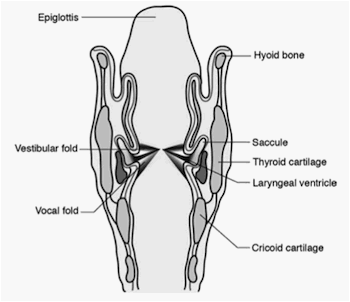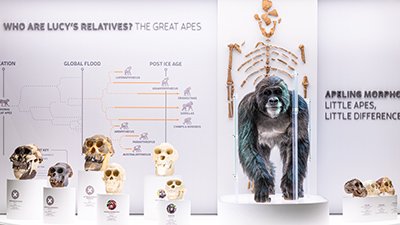
Recreating Ancient Voices
I love Lucy’s voice: it sounded just like an ape!
News Source
- Discover: “Big Idea: Bring Ancient Voices Back to Life”
By constructing anatomical models of extinct animals, scientists make educated guesses about how those animals sounded. But the August 9, 2012, online edition of Discover Magazine shares more than sounds from the past. It acquaints readers with the insight of Bart de Boer, an “expert in the evolution of speech.”
De Boer’s research1 involved an experimental model using plastic tubes to duplicate the sounds he believes Lucy and family (fossils of the ape Australopithecine afarensis, believed by evolutionists to be our ancestor) could have produced. People listened to the sounds to see how clearly they could distinguish them. There was a great deal of blurring of sounds, especially vowels, suggesting that Lucy’s family lacked the anatomical ability to articulate precisely. Therefore, de Boer concludes that Lucy’s vocal anatomy was useful for “dominance interactions or used for territorial defense, but disadvantageous for creating subtle acoustic distinctions necessary for speech”2 and “advantageous for producing loud, low-frequency calls, but disadvantageous for producing large sets of precisely timed, subtly distinct sounds.3 In other words, Lucy probably sounded like the ape she was.
Air sacs, present in many animals but not humans, increase vocal resonance and may also prevent hyperventilation.
The anatomical clue guiding de Boer was the presence of a hyoid bulla in the Australopithecine afarensis fossil generally called “Lucy’s child.” The hyoid bone is a tiny bone near the larynx (the “voice box”). In many monkeys and apes (such as female chimpanzees), this bone has “a cup shaped extension”4 called the hyoid bulla, to which the air sacs attach. The air sacs in gorillas and chimpanzees can extend well into the neck and chest. Air sacs, present in many animals but not humans, increase vocal resonance and may also prevent hyperventilation. De Boer says, “Air sacs make sounds louder and lower-pitched, just the way a musical instrument sounds lower and louder when it’s bigger. I was in Brazil recently and heard howler monkeys in the wild. They sounded like scary monsters because of their air sacs.”

The human hyoid bone provides a support for the tongue. The female chimpanzee’s hyoid bone has a cuplike extension that provides an attachment point for the passage leading to her air sacs. (Male chimps just have a ridge.) Image from Bart de Boer, “Air Sacs and Vocal Fold Vibration: Implications for Evolution of Speech” to appear in Theoria et Historia Scientiarum uvafon.hum.uva.nl/bart/papers/deBoerTHS2010.pdf
Plastic models of primate air sacs obscure the clarity of bellowing sounds to human observers. Therefore, de Boer concludes that the changing lifestyle of the bipedal ancestors of humans made the ability to articulate an increasingly important survival skill. However, nothing about A. afarensis anatomy suggests it sounded like anything but an ordinary ape. De Boer supports his contention by the claim that humans retain useless vestigial remnants of primate air sacs in the form of laryngeal saccules and occasionally as pathoglogical laryngocoeles. He further notes that some fossils of Neanderthals and H. heidelbergensis have been found with hyoid bones lacking bulla. Therefore, he believes speech evolved between the “Lucys” and the Neanderthals. De Boer writes, “This indicates that air sacs disappeared somewhere between 3.3 million years ago and 500 000 years ago in human evolution.”5
According to Ann MacLarnon of the University of Roehampton in London, de Boer provides clear evidence supporting the idea that the need to produce complex sounds to communicate better made air sacs shrink. More sounds meant more information could be shared, giving those who lacked air sacs a better chance of survival in a dangerous world.6
De Boer has demonstrated one reason it is anatomically impossible for chimpanzees to articulate like humans. Other reasons include their lack of intricate anatomical connections between the tongue and the hyoid bone. And by pointing out that Neanderthals and H. heidelbergensis both have hyoid bones like other humans, he reminds us of recent research asserting “Neanderthals were probably able [sic] of vocalizing voluntarily, with communicative intentions and in a sophisticated way,”7 (not a surprise to us since Neanderthals and H. heidelbergensis were just people). However, de Boer has not proven anything about human evolution. He’s only shown why apes sound like apes and humans sound like humans.

The laryngeal saccule is a small blind pouch beneath the false vocal cords. Placement of the muscles that move the true vocal cords during speech cause mucous to squeeze out of the saccule to lubricate the true vocal cords, resulting in a self-regulating continual as-needed lubrication system, perfectly designed by a loving Creator to help humans speak comfortably to him and to each other. Image from P. Porter and J. Vilensky, “The Laryngeal Saccule: Clinical Significance,” Clinical Anatomy 25: 647–649 (2012). Wiley Online Library.
As to de Boer’s claim the humans bear a useless vestigial remnant of primate air sacs, analysis of human anatomy reveals a different picture.
As to de Boer’s claim the humans bear a useless vestigial remnant of primate air sacs, analysis of human anatomy reveals a different picture. The laryngeal saccule is a small blind pouch tucked up under the false vocal cords. Lined with an abundance of mucous-producing glands, it lubricates the vocal cords simultaneously with their movements. The precise placement of the muscles that move the vocal cords causes them to compress the saccule and squeeze out mucous just when it is needed. No other function8 is known for the laryngeal saccule in humans, but lubrication of the vocal cords seems valuable enough, hardly making the saccule a useless vestige!9
A laryngocoele is an enlargement of the saccule. Small laryngocoeles occur in about 8% of normal people. Large laryngocoeles may present as neck masses full of mucous, pus, or just air—particularly in people who play wind-instruments. Enlargement is also sometimes associated with laryngeal cancer.10 Pathological laryngocoeles are products of a sin-cursed world, not evolutionary throwbacks to primate air sacs.
Thus, this laryngeal saccule design serves the needs of human beings, who can accomplish more by speaking than bellowing. Air sacs serve the functions for which God designed them in primate animals—apparently to augment their useful bellowing while preventing hyperventilation—but primate animals are not designed with either the mental or anatomical ability to speak. God, our common Designer, intended the differences to make our bodies and theirs work the way He intended. Adam and Eve were created as fully formed human beings with the ability to speak. Speech did not have to evolve. Nothing about this research lends credence to notions about human evolution.
Further Reading
- We Now Know That Lucy Said: “Duh . . . duh . . . duh”
- A Look at Lucy’s Legacy
- Did Humans Really Evolve from Apelike Creatures?
For More Information: Get Answers
Remember, if you see a news story that might merit some attention, let us know about it! (Note: if the story originates from the Associated Press, FOX News, MSNBC, the New York Times, or another major national media outlet, we will most likely have already heard about it.) And thanks to all of our readers who have submitted great news tips to us. If you didn’t catch all the latest News to Know, why not take a look to see what you’ve missed?
(Please note that links will take you directly to the source. Answers in Genesis is not responsible for content on the websites to which we refer. For more information, please see our Privacy Policy.)
Footnotes
- B. de Boer, “A Biolinguistic Approach to the Vocalizations of H. Neanderthalensis and the Genus Homo,” Journal of Human Evolution 62, no. 1 (January 2012): 1–6, doi: 10.1016/j.jhevol.2011.07.007.
- Ibid.
- Ibid.
- Ibid.
- Ibid.
- C. Harvey, “Our ancestors speak out after 3 million years,” New Scientist, November 23, 2011 http://www.newscientist.com/article/mg21228404.400-our-ancestors-speak-out-after-3-million-years.html.
- L. Barceló-Coblijn, “A Biolinguistic Approach to the Vocalizations of H. Neanderthalensis and the Genus Homo,” Biolinguistics 5, no. 4 (2011), http://www.biolinguistics.eu/index.php/biolinguistics/article/view/188.
- The saccule, like other structures in a child’s upper respiratory system, also has infection-fighting lymphoid tissue that regresses with age. Comparative anatomist Victor Negus (1949, cited in J. Delahunty and J. Cherry, “The Laryngeal Saccule,” The Journal of Laryngology and Otology 83, no. 8 (August 1969):803–815, June 29, 2007, http://journals.cambridge.org/action/displayAbstract?aid=1164052) claimed this as support for the saccule being only a useless evolutionary left-over. However, the evolution of humans from ape-like ancestors is not recapitulated by the growth of a child to an adult. Negus’s conclusion was based on a false analogy.
- Some animals have saccules but without the abundant mucous-producing glands found in humans. Therefore, D.F.N. Harrison’s text on comparative anatomy of the larynx reports the lubrication in humans must be unimportant because other sources of mucous in the respiratory tract are sufficient. (from D.F.N. Harrison’s book The Anatomy and Physiology of the Mammalian Larynx, published by Cambridge University Press in 1995, pages 93 and 95.) These conclusions ignore the more refined design suited for humans, for whom speech is very important, instead maintaining the fiction of our common ancestry with apes.
- Information about the laryngeal saccule and laryngocoeles obtained from P. Porter and J. Vilensky, “The Laryngeal Saccule: Clinical Significance,” Clinical Anatomy 25:647–649. onlinelibrary.wiley.com/doi/10.1002/ca.22015/full and K. Fredrickson and A. D’Angelo Jr., “Internal laryngopyocoele presenting as acute airway obstruction: Ear, Nose and Throat Journal 86 (2):104-108 and J. Delahunty and J. Cherry, “The Laryngeal Saccule” The Journal of Laryngology and Otology 83(8): 803–815. Published online 29 June 2007 at journals.cambridge.org/action/displayAbstract?fromPage=online&aid=1164052.

Answers in Genesis is an apologetics ministry, dedicated to helping Christians defend their faith and proclaim the good news of Jesus Christ.
- Customer Service 800.778.3390
- Available Monday–Friday | 9 AM–5 PM ET
- © 2025 Answers in Genesis


